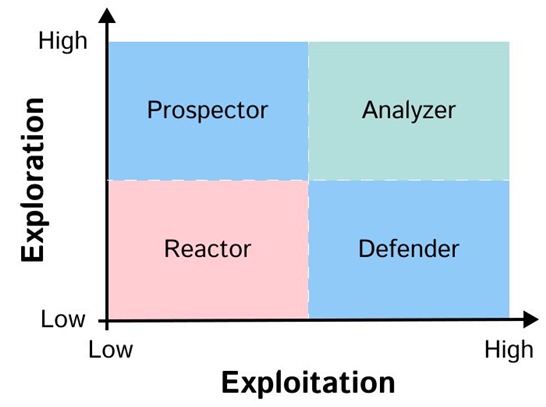Miles and Snow Strategy Typology
What is Miles and Snow's Organizational Strategy?
Introduction
One of the most influential frameworks that explains how companies can respond to change is the Miles and Snow Strategy, introduced in 1978 by Raymond Miles and Charles Snow (Jerab et al., 2023). Unlike models that focus only on market position, the Miles and Snow Strategy emphasizes internal consistency and alignment between strategy, structure, and processes.
To better understand the framework, this article explains the four strategic types identified by Miles and Snow: Defender, Prospector, Analyzer, and Reactor. Each type shows different ways on how companies deal with change, take risks, and plan growth.

The Four Strategic Types:
1. Defenders
Defenders focus on doing a good job on a limited number of things. Specifically, these organizations work best in stable environments. They will usually prioritize efficiency, cost control, and continuous improvement. Additionally, they protect their existing market by maintaining high-quality processes and defending their core competencies.
For example, many traditional manufacturing companies, such as automobile or utility firms, often adopt a Defender strategy. Their strength lies in standardization and operational excellence.
Pros:
- High internal efficiency
- Strong expertise in specific areas
- Predictable and consistent performance
Cons:
- Vulnerable to disruption
- Less flexible to environmental change
- Risk of obsolescence in dynamic industries
2. Prospectors
Prospectors are the opposite of Defenders (Herawati et al., 2024). These firms actively seek new markets, products, and opportunities. Furthermore, they operate in dynamic environments and thrive on innovation, flexibility, and experimentation.
For example, technology startups, R&D-driven companies, or digital platforms, like Netflix or Tesla in their early years, adopted this strategy. They move fast and often reshape entire industries.
Pros:
- High growth potential
- Early mover advantage
- Strong adaptability to change
Cons:
- High risk and cost
- Resource-intensive
- May lack internal efficiency
3. Analyzers
Analyzers combine elements of both Defenders and Prospectors (Anwar et al., 2025). They maintain a stable core business while selectively innovating in other areas. This dual approach allows them to exploit existing strengths while also exploring new opportunities cautiously.
The mix of stability and innovation is known as strategic ambidexterity. It shows a company's ability to explore new markets while exploiting existing ones. This ability is often seen as a modern evolution of the Analyzer strategy (Pertheban et al., 2023).
For example, large multinational companies like Microsoft or Samsung often follow this strategy. They keep on improving their products while experimenting with new innovations.
Pros:
- Balanced risk and reward
- Leverages both efficiency and innovation
- Flexible yet stable
Cons:
- Requires complex structure and decision-making
- May face internal tension between old and new divisions
4. Reactors
Reactors lack a consistent strategy (Thoumrungroje et al., 2022). Unlike the other three types, reactors respond to changes only when forced to. Often, they do so without proper planning or direction. As a result, this reactive behavior can lead to poor performance and organizational instability (Andrisa et al., 2021).
For example, companies that fail to adapt to technological change (like Kodak with digital photography or Blockbuster with streaming) often illustrate the dangers of being a Reactor.
Pros:
- None strategically; may occasionally benefit from luck or short-term adjustments
Cons:
- Poor long-term performance
- Lack of clear direction
- High vulnerability in competitive markets
Final Thoughts
Even today, the Miles and Snow strategy remains relevant. This is largely due to its focus on internal consistency and strategic alignment. When applied properly, every strategic type—except for Reactors—can lead to success, as long as it fits the company's environment and is executed properly.
Ultimately, the key lies in recognizing your organizational type, adapting when needed, and ensuring all elements of the business—structure, culture, and processes—work toward the same strategic goal.
References
Andrisa, G. N., & Modreanu, A. (2021). Business Strategy: Choosing the Right Fit. “Ovidius” University Annals, Economic Sciences Series, 21(2), 570-574. http://dx.doi.org/10.61801/OUAESS.2021.2.80
Anwar, J., Butt, I. and Ahmad, N. (2025). SMEs’ strategic orientation through Miles and Snow typology: a synthesis of literature and future directions. Management Research Review, 48(2), 258-286. https://doi.org/10.1108/MRR-12-2023-0914
Herawati, H., Naufal, Y., Lusiana, S., & Audina, N. R. (2024). Business strategy for minimizing taxes. International Journal of Management and Business Applied, 3(2), 182–192. https://doi.org/10.54099/ijmba.v3i2.1089
Jerab, D. A., & Mabrouk, T. (2023). Miles & Snow’s Competitive Strategies and their HRM Implications. SSRN Electronic Journal. https://doi.org/10.2139/ssrn.4566904
Pertheban, T. R., Thurasamy, R., Marimuthu, A., Venkatachalam, K. R., Annamalah, S., Paraman, P., & Hoo, W. C. (2023). The impact of proactive Resilience Strategies on organizational performance: Role of ambidextrous and dynamic capabilities of SMEs in manufacturing sector. Sustainability, 15(16), 12665. https://doi.org/10.3390/su151612665
Thoumrungroje, A., & Racela, O. C. (2022). Innovation and Performance Implications of Customer-Orientation across Different Business Strategy Types. Journal of Open Innovation Technology Market and Complexity, 8(4), 178. https://doi.org/10.3390/joitmc8040178
SDG's: 4 - Quality Education


Comments :